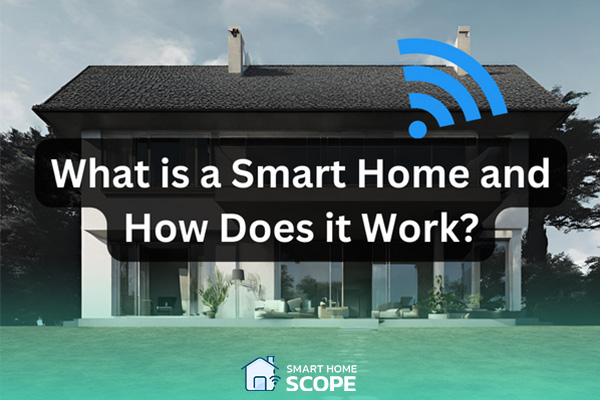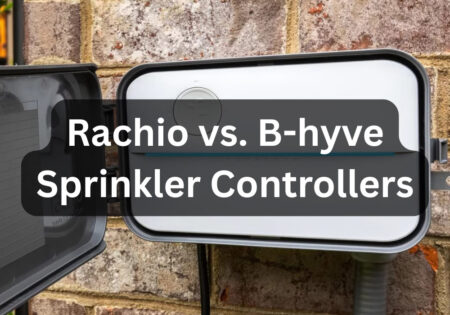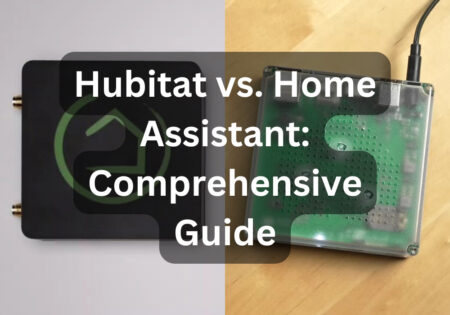What is a Smart Home? What does it have, and how does smart home technology work? These are all questions that come to mind when we are getting to know this new living style. Smart gadgets can enhance your life in many ways, contributing to a safer, more efficient, and more comfortable living. With the right setup, you can set these devices to work in harmony and elevate your experience. I am Erfan Askari, and in this article, I’ll tell you all about smart homes to get you started with the process of becoming a smart home owner!
What is a Smart Home? What do Smart Homes Control?
A smart home essentially represents the pinnacle of integrating technology within our homes, blending convenience, efficiency, and personalization to revolutionize how we live in our spaces. However, what precisely qualifies a home as “smart”? It goes beyond simply having the newest technology or being able to use your smartphone to manage your thermostat and lighting. Smart homes are not just about smart devices, but a network—a well-ordered grid of tools that can interact with each other and be used to your advantage to maintain your daily routine based on adjustments that fit in with your habits.
Also Read:
What is the Difference between a Smart Home and a Smart Building?
The Evolution of Smart Homes
Over time, the idea of a “smart home” has changed dramatically. At first, it was just simple automation, like programmable thermostats or light timers. However, after the advent of the Internet of Things (IoT), the capabilities of smart homes have increased significantly. Nowadays, the latest houses have features such as refrigerators that remind you when they run out of groceries and speakers that are too smart for their own good.
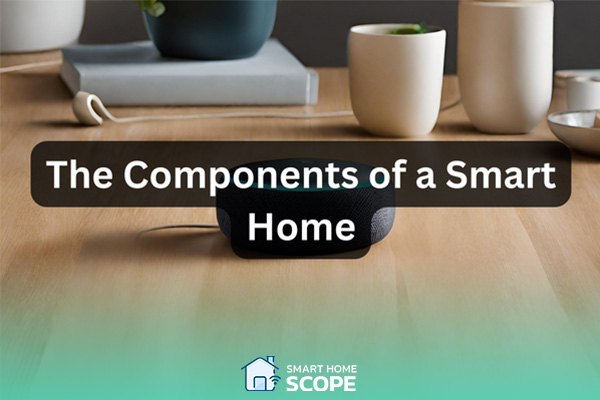
The Components of a Smart Home: What do Smart Homes Have?
The cornerstone of a smart home is made up of networked gadgets, such as but not restricted to:
- Smart Lighting: Use lights that change according to occupancy or time of day to manage the atmosphere and energy usage in your house.
- Smart Security: It doesn’t matter if you’re at home or not; security devices safeguard your home at all times and will alert you to any situation that may compromise the security of your smart home.
- Smart Thermostats: Using a smart thermostat, you can effortlessly optimize the heating and cooling system in your home.
- Smart Appliances: You can effortlessly manage your household with refrigerators, ovens, and washing machines that you can monitor and control.
- Voice Assistants and Hubs: A smart hub serves as the controller for your entire home automation system, allowing you to interface with all devices through simple voice commands using only one software application.
The Role of Connectivity
The interconnectivity of a smart home is what makes it magical. To better meet your requirements, equipment in a smart home may communicate and make choices via Wi-Fi, Bluetooth, and other wireless communication protocols. This connectivity is about developing a smart device network that interacts to make life easier and more enjoyable, not necessarily for remote control.
Personalization and Learning
The capacity of a smart home to learn from your activities and adjust itself accordingly is perhaps its most alluring feature. Many smart devices have been built with artificial intelligence (AI) capabilities, allowing them to learn from your habits gradually. It means that your smart home can deliver on your requests, such as playing your favorite music once you get home from work or warming up before you wake up on a cold morning.
The idea of a smart home still appears too futuristic or even nerdy to some people, but the level of comfort and convenience brought by a smart ecosystem in your home is unimaginable. With the right setup and utilization of AI in voice assistants, you get a fully personalized experience tailored to your needs and expectations.
How Does Smart Home Technology Work?
To thoroughly understand what a smart home can do for us, it is more than necessary to understand how smart home technology works and what it controls. Any smart home has IoT (the Internet of Things)—a network composed of connected gadgets—as its central part. With the help of this network, devices may communicate with one another, share information, and carry out orders according to your preferences and usage patterns. So let’s learn about how a smart home works and what it can do.
The Central Hub: Command and Control
A central hub, often known as a controller, serves as the brains of many smart homes. This hub can be a software platform accessed by a smartphone app or a physical device, such as a smart speaker or a home automation gateway.
The central hub allows the different smart gadgets in your home to function together smoothly by coordinating their actions. For example, telling your smart speaker to “start the morning routine” will cause your lights to come on, your preferred news station to play, and your coffee to start all at once.
Also Read:
Hubitat C8 vs. C7
Communication Protocols: The Language of Smart Devices
Devices in a smart home need to communicate with one another and the central hub using a standard language. Protocols for communication come into play here. Devices may communicate with one another and the internet thanks to protocols including Bluetooth Low Energy (BLE), Wi-Fi, Zigbee, and Z-Wave. Each protocol has its advantages and disadvantages. For example, WIFI’s high bandwidth makes it perfect for data-intensive applications, while Z-Wave and Zigbee work well together to create low-power mesh networks that guarantee dependable communication even in large households.
Artificial Intelligence and Machine Learning: The Brain Behind the Operation
Artificial intelligence (AI) and machine learning algorithms integrated into smart gadgets are the source of a smart home’s actual intelligence. The AI built into various smart devices in your setup helps them to act as you need them to. For instance, a smart thermostat can gradually learn your routines and the desired temperature levels for your home, thus automatically adjusting to keep the house within that level of comfort without seeking human intervention.
Cloud Computing: Remote Access and Control
Cloud computing plays a role in enabling access and control, making it an indispensable component for the functionality of smart homes. Using a web interface or smartphone app, you can communicate with your smart home over the cloud from any location in the globe. This handy capability allows you to keep an eye on and manage your household systems from afar, providing not only convenience but also playing a role in energy efficiency and safeguarding your home.
Integration and Automation: Creating a Cohesive System
Creating an automated system that improves your quality of life is the ultimate objective of a smart home. Several different devices may cooperate through scenes, routines, and automation mechanisms to accomplish complicated duties. For example, say “movie time” to your voice assistant, and automation may lower your smart blinds, dim the lights, and switch on your TV. At this point, a collection of smart gadgets becomes a unified, smart ecosystem that understands and anticipates your wants.
In brief, a smart home is made up of an intricate web of gadgets, protocols, and technologies that work in concert to create a convenient, responsive, and lifestyle-specific environment. The possibilities are endless when it comes to how smart home devices can improve our lives, and this fact becomes more evident as more gadgets are invented.
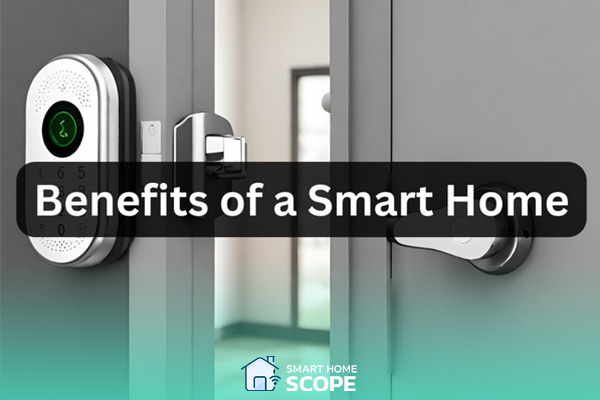
Benefits of a Smart Home
The concrete advantages that a smart home offers to daily living are just as appealing as its technological capability. Smart gadgets don’t just make your life easier; they contribute to energy efficiency too, meaning that they have environmental and financial benefits along with many more pros that we are going to explore in this section.
1. Convenience
The mere convenience that a smart home provides is its most obvious advantage. It’s never been simpler to manage your living area when you can use a voice assistant, tablet, or smartphone to control several parts of your home environment from one device. Imagine being able to change the entertainment, lighting, and temperature without having to touch each device directly. The convenience level is achievable thanks to homes simplifying chores and allowing more time for meaningful activities.
Automated Routines
The capacity to establish automated routines that carry out several tasks with a single order or trigger is one of the distinguishing features of a smart home. Morning rituals might gently wake you up by playing your favorite music and gradually brightening the lighting. In a similar vein, “goodnight” rituals can automatically lock your house, turn out the lights, and change the thermostat to guarantee a restful night’s sleep.
2. Energy Efficiency
Smart houses are excellent at maximizing energy consumption, which lowers their environmental impact and results in substantial utility bill savings. Energy is not wasted on unoccupied rooms or throughout the day, thanks to smart thermostats and lighting systems that adapt based on occupancy and natural light levels. Smart gadgets can run during times when energy rates are lower, contributing to even more savings.
Monitoring and Management
With the use of sophisticated monitoring features, homeowners can analyze their energy usage in real-time and pinpoint areas for increased efficiency. By using energy monitors, individuals can make decisions about their usage and potentially switch to more energy-saving alternatives by understanding which devices consume the most electricity.
3. Security
Security of smart homes is robust and one of their most important benefits. Without sacrificing home security, smart locks provide keyless entry and the option to temporarily allow guests into the house. Real-time monitoring and notifications are provided via video doorbells and security cameras, enabling homeowners to keep an eye on their property from any location.
Remote Monitoring
Not only does having remote home monitoring improve security, but it also gives you peace of mind. While at work, on vacation, or anywhere else, smart security systems notify you about any abnormal conduct so that immediate actions may be taken if required.
4. Accessibility
People with mobility or other disabilities can count on smart homes for better independence and life quality. Regardless of physical constraints, voice commands and streamlined interfaces make controlling the home environment more accessible to everybody.
Enhancing Independence
Automated devices and voice-activated controls can significantly improve daily living for those with restricted mobility. This means that even when no assistance is available from others, the technology in a smart home allows people to have power over their living environment, from temperature control to curtains.
In conclusion, I can say that smart homes are beneficial in many areas. They are more environmentally friendly and cost-effective because of their energy-saving features, they enhance security, and contribute to the security of you and your home! All these features make smart homes a must in our modern world, not just a luxury service.
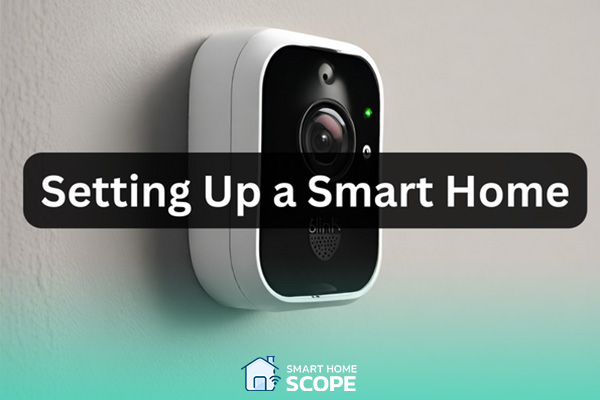
Setting Up a Smart Home
Starting the process of building a smart home may be intimidating as well as thrilling. In order to achieve a seamless setup, you should be careful when planning and decide on an ecosystem that is well-aligned with your lifestyle and preferences. Below I’ve provided a step-by-step guide to help you start setting up your smart home.
Choosing the Right Ecosystem
It may be thrilling and intimidating to start the process of building a smart home. The secret behind a successful setup is early preparation plus finding out the best content based on individual preferences and way of living. To get started building a smart home for your convenience, which would make your life easier and happier too, here is what you need.
- Compatibility: Verify that the platform works with a variety of gadgets and brands that you find appealing.
- Usability: The platform should have an easy-to-use interface and simple device management.
- Privacy and Security: To safeguard your data, check out the platform’s privacy policies and security measures.
Starting with the Basics
Begin with a few simple smart devices once you’ve selected your ecosystem to get a sense of how they function and interact. These might consist of:
- Smart Speakers or Displays: Act as the main hub for voice control and the management of other smart devices.
- Smart Lighting: This energy-efficient and convenient solution is simple to install and provides instant advantages.
- Smart Thermostats: Adjust to your schedule and preferences to help you control heating and cooling more effectively.
Expanding Your Smart Home
You may progressively add more devices to your setup as you get more accustomed to it to increase convenience and functionality. Think about adding:
- Smart Locks and Security Cameras: By enabling remote access point monitoring and control, these devices improve security.
- Smart Appliances: These may bring a level of ease to your everyday routines, ranging from smart ovens to refrigerators.
- Smart Sensors: You can increase the efficiency and security of your home by automating chores using motion, door/window, and environmental sensors.
Integration and Automation
The automation of routines and device integration are where a smart home shines. Most ecosystems let you set up scenarios or automation that, when certain instructions or circumstances are met, cause several devices to activate. Consider establishing habits that match your lifestyle, like creating a “Welcome Home” setting that triggers your tunes, turns on the lights, and adjusts the temperature upon your arrival.
Ongoing Maintenance and Updates
Ensuring the security and performance of your home is crucial by updating devices with the latest firmware. By reviewing your setup regularly, you can optimize some factors such as the placement of devices and the automations based on your own taste.
There are many opportunities for improving your lifestyle when setting up a smart home. You can build a smart home that simplifies your life and changes with your requirements over time by beginning small, selecting the appropriate ecosystem, and working your way up.
Challenges and Considerations
Though there’s no denying the appeal of turning your house into a smart sanctuary, it’s important to walk this route mindful of potential obstacles and concerns. While smart home technology offers benefits, it comes with its set of challenges and complexities that homeowners should stay informed about.
Compatibility and Interoperability
Ensuring that every gadget in your house can connect with every other device is one of the main problems of setting up a smart home. Since there are so many manufacturers and ecosystems available, not every gadget is made to function flawlessly with every other device. This may result in a disjointed smart home experience, with certain devices functioning independently, which would reduce the ease and effectiveness that smart homes are supposed to offer.
Solutions:
- Planning and Research: Find out if new smart home appliances will work with your current ecosystem before making a purchase. Seek out gadgets that adhere to open standards for wider interoperability, such as Z-Wave, Zigbee, or the recently developed Matter protocol.
- Select a Central Hub: If you want to integrate a lot of devices and protocols into your smart home, think about purchasing a central hub. You may use this as a unifying platform to manage all your devices from a single user interface.
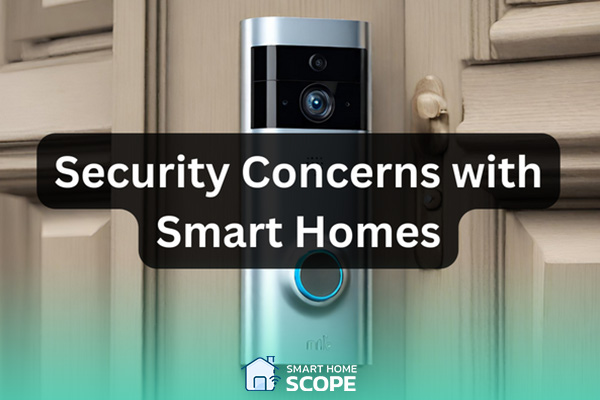
Privacy and Security Concerns
Smart homes’ interconnectedness gives rise to legitimate worries about security and privacy. There’s a chance that private information might be abused or leaked because gadgets are always gathering information about your interests and behaviors. Other than that, it isn’t true to say that smart gadgets are fully immune to hacking! Meaning that attackers have the opportunity to compromise your privacy.
Solutions:
- Secure Your Network: Make sure the Wi-Fi network at your house is safe by setting up network encryption and using strong, one-of-a-kind passwords. Update the firmware on your router regularly to guard against security flaws.
- Update Devices Frequently: To address security flaws, manufacturers of smart devices frequently provide software updates. To keep your devices safe, be sure to apply these updates as soon as possible.
- Examine privacy statements: Recognize the types of data your smart devices are gathering and how they are using it. Buy products from brands that are well-known and dedicated to safeguarding user data. They must be honest about their privacy policies.
Technical Complexity and Learning Curve
It can be technically difficult to set up and manage a smart home, especially for people who are not tech-savvy. For novices, the first setup might be intimidating as it entails installing devices, setting up automation, and resolving connectivity problems.
Solutions:
- Start Small: Begin with a few fundamental smart devices and work your way up to a more complex configuration. This lets you get acquainted with the technology at your speed.
- Ask for Help: A lot of manufacturers have online forums and customer service where you may ask questions and get troubleshooting guidance. Never be afraid to ask for assistance when you need it.
Cost Considerations
Although energy conservation in smart home devices can result in long-term savings, there might be a substantial initial expense. Premium smart gadgets are frequently expensive, and furnishing a whole house may get expensive fast.
Solutions:
- Order Your Necessities: Pay attention to the gadgets that will benefit your lifestyle the most. Consider purchasing a high-quality smart security system before looking at other gadgets if, for example, home security is your top concern.
- Search for Offers: Take advantage of special offers and discounts to save money on smart home appliances. Bundle offers are available from many merchants and can lower the total cost.
While smart homes offer lots of advantages, there are some concerns that come along with them. Learning about these concerns when setting up your smart home
The Future of Smart Homes
The upcoming advancements in homes are set to be more interconnected user-friendly, and essential to our routines as we approach a pivotal technological shift. The definition of a “smart home” is about to change due to the rapid emergence of artificial intelligence (AI), machine learning, and the Internet of Things (IoT). It’s time to examine what the future holds for smart home technologies.
Enhanced AI and Machine Learning
Not only will the smart house of the future obey directions, but it will also sense needs and provide answers before they are specifically asked for. This progress will be greatly helped by AI as well as machine learning so that gadgets can learn from what you like or do so that they can automate their jobs more successfully. For example, without your involvement, your house may sense when you’re coming and change the lights, music, and temperature to your preferred setting.
Seamless Integration and Interoperability
The future smart home will offer unmatched device integration and interoperability, irrespective of the manufacturer, thanks to the adoption of global standards like Matter. Consequently, this could result in the formation of an actual consistent ecosystem allowing for simple communication as well as sharing devices among each other thus providing a much smoother customer experience. Imagine a future in which your automobile could talk to your house to initiate the coffee maker and turn on the garage lights as you get closer to your house.
Advanced Home Security
Smart houses will have more security than just alarms and security cameras. Thanks to the cutting-edge technologies that will continue to advance in the future, such as biometric verification or face recognition, even motion sensors, security is going to become even tighter in smart homes. Your house will be safe and only accessible to those you trust thanks to these systems’ individualized access control and intrusion prevention features.
Energy Efficiency and Sustainability
Future smart houses will prioritize sustainability and energy efficiency more than ever as environmental concerns increase. Integrating energy systems that store electricity in batteries and leverage sources can enhance real-time energy consumption optimization resulting in a decrease in carbon emissions. Homes will be not only more energy-efficient but also capable of producing and supplying it back to the grid.
Health and Well-being
The health and well-being of the people living in smart homes will become more and more important. Sophisticated sensors will keep an eye on humidity, air quality, and other environmental aspects to guarantee ideal living circumstances. To measure health indicators and modify the environment appropriately—for example, by changing the lighting to enhance sleep quality or reminding you to drink more water—wearable devices will interact with home systems.
The Rise of Smart Cities
As smart cities—where residences interact with urban infrastructure to provide more ecological and efficient living spaces—develop, so will smart houses too. This interconnection means better quality of urban life due to fewer traffic congestions, improved emergency response systems as well as more efficient resource management.
To sum up, technology’s effect on smart homes in the future is going to improve sustainability, security as well as responsiveness within our living environments. By adopting these improvements, our houses shall cease merely being comfortable and safe; they shall play an active role in bettering our quality of life on earth and enhancing our health.
Conclusion
In conclusion, I can say that the answer to what is a smart home is a place that brings security, convenience, and efficiency to your life! Learning about how does smart home technology works and its components can help you start your life as a true smart home owner and that’s exactly what we talked about in this article.




